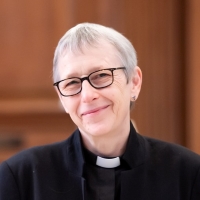There is something rather nice about having the chance to preach on the theme of Candlemas – the Presentation of Christ in the Temple – during a service of Evensong. Because, of course, one of the canticles that we hear the choir sing every Sunday evening here, the Nunc Dimittis, is a setting of the New Testament text from the story that lies at the very heart of this celebration.
Just to remind you of that story: in accordance with the Jewish tradition of their day, St Luke recounts how Mary and Joseph, at the designated time, took the child Jesus to the Temple, to be presented to the Lord, and to offer sacrifice. There they encountered the elderly Simeon, a devout and righteous man, who had been told by the Holy Spirit that he would not see death until he had seen the promised Messiah.
And seeing the child Jesus, Simeon recognises him instantly as the one who would come to bring salvation to his people and light to the Gentiles – and he utters those marvellous words that we hear the choir sing here each week:
Lord, now lettest thou thy servant depart in peace: according to thy word,
For mine eyes have seen thy salvation;
Which thou hast prepared before the face of all people;
To be a light to lighten the Gentiles and to be the glory of thy people Israel.
There is something both poignant and beautiful about the vision of a man who feels free to embrace his own death, at one with his God, and with his heart fully at peace, because he knows that hope has come into the world at last. Note that Simeon doesn’t need to see that hope fully accomplished – the unfolding of the ministry of Christ is still many years away: all that he sees before him now is a tiny baby. But Simeon can die in peace because he now knows enough. He knows that everything will be alright, even though he won’t be there to see it through to fulfilment himself.
One of the greatest privileges of ministry is to spend time with those who are preparing for their own deaths, who really are at peace with what lies ahead of them. Usually these are people who are old and full of years, although that is by no means always the case. I have known individuals who were relatively young, who might have been expected to live for many more years had it not been for the intervention of serious illness – but who nevertheless were able to look at their lives, and at the people around them and say: ‘Yes, this is alright. It is not the path I would have chosen for myself. But it is OK. I have done what I needed to do, and so much of what I see around me feels like gift. And I can now take my leave.’
Despite having every justification for self-pity, and sometimes enduring much pain and discomfort, such people can become true bearers of light and hope to those around them.
Like many ordained ministers, I am the product of years of psychotherapy. We clergy spend so much of our professional lives dealing with the trauma, pain and bereavement of other people, that this is always wise: you cannot pastor responsibly or wisely until you have dealt with your own issues, and attended to your own scars. And many years ago, when I was still newly ordained, I worked for a very long time with a wonderful psychotherapist, who changed my life in all kinds of ways. She was a medic by background, and had specialised in psychiatry before setting up her own private practice in psychotherapy. And she was just excellent: she was wise, she was immensely insightful, and she was always a consummate professional. She was also very clear about boundaries, so although I went to her house for my appointments with her, I knew relatively little about her at a personal level, even though I saw her there for a number of years.
Until, that is, a couple of years ago, when quite by chance I stumbled across obituaries of both her and her husband (who I discovered had been extremely eminent in a completely unrelated profession). They had died within a few weeks of one another in a nursing home, both aged in their nineties. And because they were highly respected in their different professions, both of their obituaries were long and detailed – so I discovered all kinds of things that I didn’t know before, including the woman’s amazing achievements – in her case she had undertaken ground-breaking work in transforming psychiatric practice, and setting up a regional Institute of Psychotherapy – alongside her gifts as a highly accomplished amateur musician, and her love of gardening – alongside her family life, which, I discovered, was also immensely important to her.
And although I was sad to learn of her death, of course, there was something rather wonderful to see such a clear account of a long life that, so self-evidently, had been well-lived. A life in which she had contributed so much to her profession and to the individuals whom she had supported; and to the people around her; but in which she had also found deep and lasting enjoyment in all kinds of other ways, too.
And the other thing that I learned about her, that I had long-suspected but never knew for certain until I read that obituary, was that she was also a woman of profound Christian faith.
In earlier centuries, when life was much more precarious, and life-expectancy far shorter than it is today, death was viewed rather differently from the way it is now. Ours is a society that tries not to think about death too much: many of our old people die in hospitals and nursing homes, hidden from view; the care of the deceased is now in the hands of professionals rather than family members.
But back in the seventeenth century, when things were very different, the priest and Anglican divine, Jeremy Taylor, wrote a whole treatise on the subject of Holy Dying. His thesis was that ‘Death meets us everywhere’; and that the secret of a peaceful and holy end is to be found in how we live in this life now. God has given us sufficient time for this task, if we do but recognise it. Yes, life is full of pain and troubles and distractions: but, Taylor maintained, strive to live well, so that you can die well. Indeed, sometimes the very trials that face us in life are part of that preparation. As he put it: ‘No man is more miserable than he that hath no adversity; that man is not tried, whether he be good or bad.’ And, appropriately enough, Taylor also penned a companion volume called Holy Living.
So today we give thanks for Simeon, who could depart in peace; we give thanks for all those close to our own hearts, who now rest in God. And perhaps we should all strive to lead a ‘godly, righteous and sober life,’ as the opening bidding to this service so memorably puts it. Because Holy Living leads to Holy Dying.
Amen.



